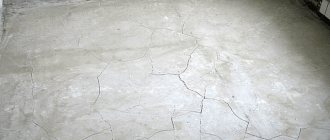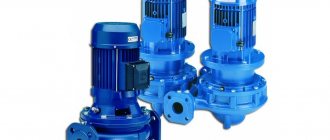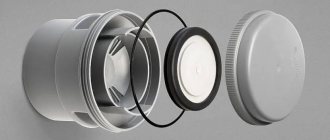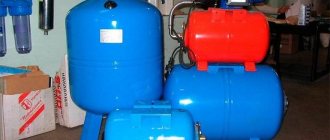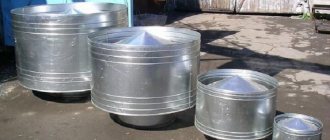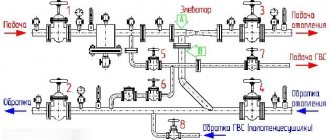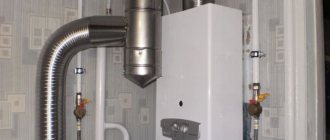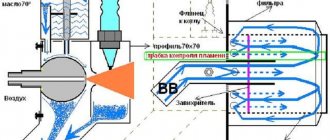The main purpose of an exhaust ventilation umbrella is to protect vertical ventilation ducts from rain, snow, and leaves. Even such a small exhaust ventilation part as an umbrella must comply with technical standards. An unsuitable ventilation hood can cause poor draft, precipitation, or clogging of the system.
The size and type of umbrella is selected depending on the parameters of the ventilation duct neck. Protective devices are produced in accordance with specifications and GOSTs; their dimensions and characteristics are determined by SNiPs.
What is it and how does it work?
Any air purifiers or humidifiers will not cope with the soot generated during cooking. Above a gas or electric stove you need a powerful hood with a dome, the dimensions of which exceed the area of the cooking surface. This role is played by an umbrella. The device does not occupy useful kitchen space, being in a suspended state.
Exhaust domes are installed above household stoves, in food industry workshops, and chemical laboratories. Umbrellas are used wherever there is a risk of air pollution with harmful impurities. Install hoods above a source of high humidity and temperature.
There are many types of umbrellas, but the design and installation features of each model are similar. Let's start our review of the engineering structure with the device.
The basis of the device is a metal casing - the vault. There is a hole in the center through which dirty air is sucked in. The role of the chimney is played by the ventilation duct. The outlet of the device is connected to the channel by a metal air duct.
Depending on the model, the exhaust device is equipped with the following elements:
- For forced exhaust of contaminated vapors, an electric fan is installed in the ventilation hole of the dome. The presence of turbines is typical for all modern hoods.
- Filter for catching fat impurities.
- Spark arrestor. Exhaust products installed above an open fire source are equipped with mesh.
- Backlight. For ease of work, lamps are mounted inside the dome.
- Mounting fastening elements.
The umbrella works on the principle of forced ventilation. Dirty air collects under the dome. A rotating turbine sucks it in and discharges it through an air duct to the street. The filter system traps impurities of fats and soot, preventing them from accumulating on the fan blades.
Chimney umbrella - what is it and why is it needed?
A protective umbrella is the top of a cap, which in appearance can be a cone, a pyramid, a semicircle or other, more complex structures and shapes.
The functions of the umbrella, which is installed on the chimney pipe, are as follows:
- prevents atmospheric water or snow from entering the chimney . A side effect of heavy rainfall is the accumulation of a large amount of moisture in the chimney pipe, causing a decrease in natural air draft;
- equipping a brick chimney with an umbrella prevents destruction of the material , and the presence of special grooves allows for the timely removal of all accumulating condensate;
- the presence of a chimney umbrella does not allow insects , animals and birds, leaves and other objects blown by gusts of wind to enter the chimney.
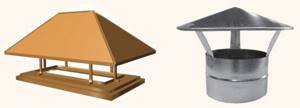
Chimney umbrellas
IMPORTANT!
You also need to remember that when using an umbrella, traction significantly improves, and the standard indicators for increasing this level of this parameter are approximately a third of the total volume.
The umbrella does not interfere with the emission of smoke with combustion products only if such a device is chosen correctly . For example, in areas with heavy snowfall, it is advisable to use additional elements with a large angle of inclination for unimpeded melting of the snow mass.
Types of umbrellas
According to the principle of operation, devices are divided into two groups:
- Exhaust models have only one function, aimed at removing dirty air from the room.
- Supply and exhaust models perform two functions: they remove dirty vaporous masses, and also provide an influx of clean air from the street.
Hoods that provide air conditioning are installed indoors where the flow of oxygen is limited. The amount of supplied fresh air is one third less than the intake of dirty air masses.
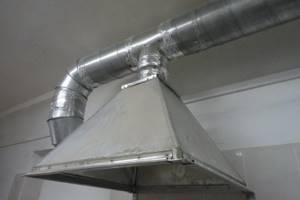
Exhaust devices are divided into three groups according to the type of design:
- A special feature of wall-mounted hoods is the presence of one row of filters that trap grease. The dome is attached to the wall above the hob or other equipment.
- Island-type models are equipped with two rows of filters. High-performance hoods are suspended from the ceiling by cables or chains. Domes are placed over free-standing devices of large dimensions in any part of the room. Rectangular models can be hung against the wall.
- Transition umbrellas are installed over an open source of fire. In everyday life they are hung over barbecues. The dome must be equipped with a spark-extinguishing mesh.
All models of umbrellas have a cross-sectional shape of a trapezoid, rectangle or triangle. Depending on their purpose, hoods can be used for domestic or industrial use.
Industrial
Umbrellas for industrial ventilation systems are distinguished by their large dimensions and the presence of a powerful fan. The filter set is equipped with special catchers. The settled impurities of fat flow from them into the glass.
Periodically, the container requires cleaning, followed by rinsing with detergent.
Household
Hoods for domestic use are equipped with disposable filters made of paper or fiber. Umbrellas are usually produced as a wall-mounted type, since in the kitchen the stove is most often located against the wall.
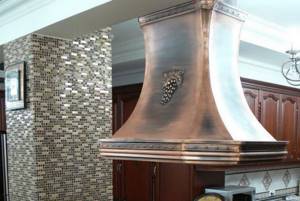
The devices are equipped with a less powerful fan, and the dimensions are designed to fit the hob area of a household stove.
How it works?
A device of this type is a powerful hood designed to effectively ventilate air in a kitchen area. They are most often installed directly above cooking surfaces in restaurants, cafes, canteens and other catering establishments.
Such a device can be installed not only over conventional kitchen stoves, but also over other similar equipment: grill, oven, etc.
The quality of dishes will only benefit from the presence of a good hood. Umbrellas trap water vapor, particles of oil and fat, and remove odors emanating from prepared dishes. All these contaminants rise upward under the influence of hot air and enter the working cavity of the ventilation hood. Here, the polluted air passes through a filtration system, where the purification process takes place.
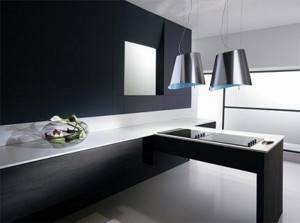
An exhaust hood is a stylish and modern device that will provide effective air purification in a domestic or industrial kitchen.
Then the air masses, freed from unnecessary inclusions, are returned to the kitchen area or removed through the ventilation duct, depending on the type of device.
Fatty contaminants move through a separate channel and are collected in storage cups, from which they are periodically removed.
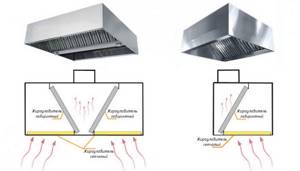
Grease traps are special aluminum elements that are installed inside exhaust hoods. They trap particles of fat and other relatively large contaminants
To facilitate the process of cleaning storage units from fat deposits, it is recommended to first pour a special detergent into the glasses that can effectively dissolve fat.
The advantages of umbrella-type exhaust structures include the following:
- the ability to use remote control;
- high degree of automation;
- the ability to install a suitable model in almost any area of the kitchen;
- a wide selection of different models made from various materials with attractive designs;
- high level of productivity.
Among the disadvantages of such equipment, first of all, increased noise generation caused by the operation of a powerful fan is noted. To ensure proper operation of the unit, it must be serviced regularly, i.e. purchase and promptly replace carbon filters.
These items cannot be cleaned or refurbished and may cost more to operate than expected. In addition, good equipment of this type is quite expensive in itself.
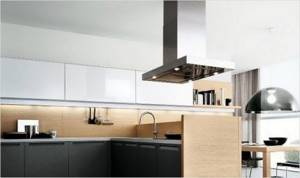
An island umbrella can be installed right in the middle of the kitchen if the size of the room allows it. In a small room, such a device can be placed above a stove installed near the window.
Exhaust hoods are always necessary in the kitchen. Particles of grease, hot steam, soot, drops and other contaminants may not be noticeable at first glance, but over time they form a layer of dirt on various surfaces that is not easy to remove.
In addition, gas residues that can enter the kitchen air and the smell of accidentally burnt food are also not good for the health of others.
The design of the ventilation hood is a steel dome-shaped housing, inside of which there is a fan and a set of filtration elements. A special aluminum grille is designed to collect relatively large particles, which protects the ventilation turbine.

In catering establishments, powerful exhaust hoods are required for use over cooking surfaces. Similar devices are used to remove harmful fumes in other industrial plants.
An acrylic filter is usually used to remove a significant portion of grease contaminants. In installations with recirculation, it is mandatory to use a carbon filter, which provides fine air purification. The spark-extinguishing mesh protects the elements from overheating and possible fire.
It is especially necessary if the umbrella is installed above a device with an open flame. All filter elements must be periodically cleaned or replaced. Carbon filters are replaced as soon as they become dirty; these elements cannot be restored.
Some types of acrylic filters can be washed and reinstalled, but this treatment quickly causes them to lose their shape, so the number of cleaning and recycling cycles is limited.
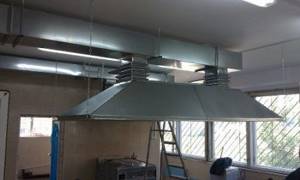
The exhaust hood must be large enough to cover the parameters of the hob being processed by at least 100 mm
A fan or ventilation turbine built into the umbrella ensures air circulation in the right direction with the required intensity. The performance of this element provides the total power of the hood, which should be correlated with the total volume of the room in which it will be installed.
Most umbrella hoods are equipped with lighting, which is very convenient. Such lamps can be used as additional lighting in the kitchen. Along with conventional incandescent lamps, halogen or diode lighting fixtures are built into hoods.
The latter provide a sufficient level of illumination with minimal electrical energy consumption and an increased service life.
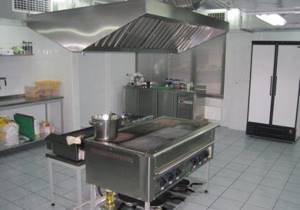
In industrial catering establishments, exhaust hoods are installed over various types of devices: stoves, grills, ovens, etc.
If the umbrella is connected to the ventilation duct of the house, it must be equipped with special valves that prevent the air masses entering the device from returning to the kitchen area.
Types
According to the type of installation, ventilation elements are divided into built-in, flat, and dome structures.
Built-in
Built-in devices are characterized by quiet operation. Install the hood directly above the hob. Operation is carried out in air circulation and exhaust mode.
Flat
Flat-type exhaust devices are characterized by their efficiency and the absence of an outlet pipe for connection to the air duct.
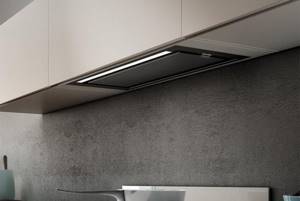
Air purification occurs due to circulation through the filter. The disadvantage of this model is its noisy operation, as well as the need for frequent filter replacement.
Dome
Dome-type models are available as wall-mounted and island-mounted. The work is carried out in air exhaust and circulation mode. Hoods have high performance, are mounted on the wall or suspended from the ceiling.
What are umbrellas made of?
Not only fats, but also steam, chemicals, and other aggressive components that cause corrosion settle on the internal surfaces of the dome. Additionally, there is a destructive effect of high temperatures. Only metal can withstand such conditions.
Industrial, as well as expensive household models are made of stainless steel.
The metal is considered heat-resistant, resistant to corrosion and acids. Cheap household appliances are made from galvanized or ordinary sheet metal, followed by painting. There are aluminum products.
How to choose an umbrella
To choose the right umbrella, three important factors are taken into account:
- The shape of the ventilation product is selected taking into account the parameters of the room, the dimensions of the slab, as well as its location. They think about the optimal method of fastening, which is influenced by the height of the ceilings.
- Size is one of the important parameters affecting the degree of indoor air purification. The dimensions of the exhaust device must be at least 10 cm larger than the dimensions of the hob. If the stove is not located near the wall, the umbrella reach is increased to 20 cm.
- The main parameter responsible for operational efficiency is productivity. To select a product with optimal air flow, take into account the height and length of the umbrella, as well as the cross-section of the filters. When comparing hoods of the same size, the performance will be higher for the product with a larger dome height.
When choosing an umbrella, pay attention to the diameter and number of connected air ducts. For household models, one output is sufficient. Four air ducts are connected to hoods with a length of 160 cm: two for exhaust and two for supply.
How to calculate power
Hoods must replace air ten times. In production, complex formulas are used to calculate power. Household models in the kitchen are not capable of changing the air ten times. Calculation of the power of the umbrella is carried out according to the parameters of the stove.
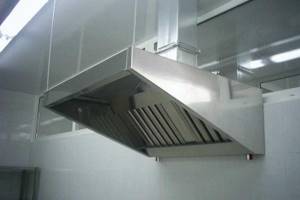
For example, there is a gas stove with four burners. Data is taken from the technical data sheet of the device. You need to find out the power of each burner and add up all the values. Let's say we get an example: 1.9+1.9+1.0+3.5=8.3 kW. The result indicates the heating output of the gas stove. It can be assumed that a maximum of three burners will be working constantly, but it is undesirable to make a smaller reserve. The thermal power parameters of the stove and hood are the same, which means that an umbrella rated at 8.3 kW is required.
DIY installation
Installing an umbrella yourself can be done in four ways, depending on the design of the product:
- wall-mounted models are attached to the wall using anchors, through technological holes on the umbrella body;
- wall-mounted and island models can be fixed to the ceiling using a pin and collet;
- island and rectangular wall models are fixed to the ceiling with chains or cables, having previously installed an anchor;
- installation on a support frame involves the manufacture of a metal structure securely fixed above the hob.
The fourth installation method is considered the most difficult. The frame is welded to the shape of an umbrella. The structure is installed on support legs with mounting plates welded to the bottom and fixed to the floor with anchors.
Installation of a protective umbrella on a pipe
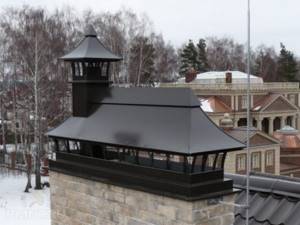
First, you need to attach racks to the top of the chimney to install the protective structure. They can be fixed in different ways, for example, you can use homemade wire frames or use clamps. The latter option is suitable for installation on asbestos and metal pipes. In the case of wire, its ends are passed through the holes for fasteners in the brackets and twisted.
The umbrella can be secured to a brick pipe with galvanized nails, which are driven into the masonry. However, it is more correct to fix the structure using self-tapping screws, which are screwed into holes pre-drilled in the brickwork. This method of fixation ensures easy and quick dismantling of the device for the purpose of repair or inspection of the chimney.
Advice! It is not recommended to install the protective element on the rivets, because the umbrella will be difficult to dismantle in order to clean the chimney.
At what height to mount
The quality of air exchange depends on the height of the umbrella installation above the hob. The parameters are displayed in the umbrella instructions. Typically, household models are removed from a gas stove to a height of 80 cm, and from an electric stove - at least 60 cm.
Now you know all the basic information about exhaust hoods and can make the right choice and installation yourself. Subscribe to other useful articles and share links on social networks with your friends who are looking for simple ways to solve complex problems.
(
1 ratings, average: 3.00 out of 5)
Features of installation and operation
Installing this type of exhaust equipment is relatively easy, but inexperienced craftsmen are still better off entrusting these operations to professionals. If you decide to carry out the installation yourself, you should start with a detailed study of the manufacturer’s instructions.

Hoods are usually made from durable food grade aluminum steel. For industrial enterprises, such designs are often created to order
After this, you need to examine the installation site, take the necessary measurements, prepare tools, fasteners, materials, etc. An important point is the correct distance from the hob. It must be at least 60 cm for electric stoves and 70 cm for gas appliances, but not more than 85 cm.
If the umbrella needs to be hung higher, then you should choose a more powerful device to compensate for the difference in height. To install an exhaust ventilation hood, you will need tools that are usually in the arsenal of any experienced craftsman: a tape measure and a building level for marking, a screwdriver, a drill, a hammer, etc.
Depending on the type of device, you will need to either simply hang it above the stove, or connect it with an air duct to the ventilation duct. Either a metal corrugated hose or rigid plastic structures are used as an air duct.
The corrugation can be bent in a suitable way, and to make a plastic elbow, special adapters should be used to ensure a tight connection of individual sections of the air duct.
If the power cord is not long enough, you need to install an additional outlet near the device. You need to make sure that the electrical appliance has the necessary grounding.
Correct installation of the ventilation hood is only half the battle. For the device to work effectively, it is necessary to organize its operation. Detailed information on such issues is contained in the operating instructions supplied with each device.
Regular cleaning of the internal filters is of great importance. For example, aluminum grilles should be washed using special detergents. A good result is obtained by using products that can be found in any kitchen: acetic acid diluted by a third with water, a saturated solution of ordinary laundry soap, or a paste mixture of water and baking soda.
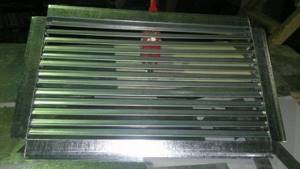
Aluminum grease traps for exhaust hoods must be regularly cleaned of accumulated dirt in order for the device to work correctly and efficiently.
These recipes will be useful for those who suffer from chemical intolerance. Grates should be cleaned of accumulated grease and dirt at least once every three months.
Replacing carbon filters is usually done in the following order:
- disconnecting the device from the power supply;
- dismantling aluminum grilles;
- removing the used filter;
- installation of a new filter element;
- installation of aluminum grilles;
- connecting and checking the operation of the device.
When installing a new filter, you should hear a characteristic click. If, after replacing the filter, unusual sounds appear in the operation of the hood or it becomes noisier, the filter may be installed incorrectly and the work should be redone.
If cleaning and replacing the ventilation hood filters is not carried out in a timely manner, the performance of the device may significantly deteriorate.
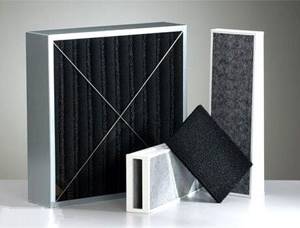
Carbon filters are necessary in hoods with circulation; they provide fine air purification and need to be replaced regularly
Removable filters and glasses for collecting grease in umbrella models that are used in catering establishments should be cleaned daily in accordance with the instructions. It is also necessary to constantly clean the outer surface of the exhaust housing. It is recommended to remove some elements and soak them in special cleaning solutions.
Once cleaning is complete, rinse them thoroughly. Another element that needs periodic cleaning is the air duct. It is necessary to remove the connecting elements and remove deposits from the internal surface of the structure.
Corrugated elements require this cleaning more often than smooth plastic channels. Some industrial models of kitchen umbrellas are equipped with a built-in cleaning system, but such expensive units are usually not used in everyday life.
